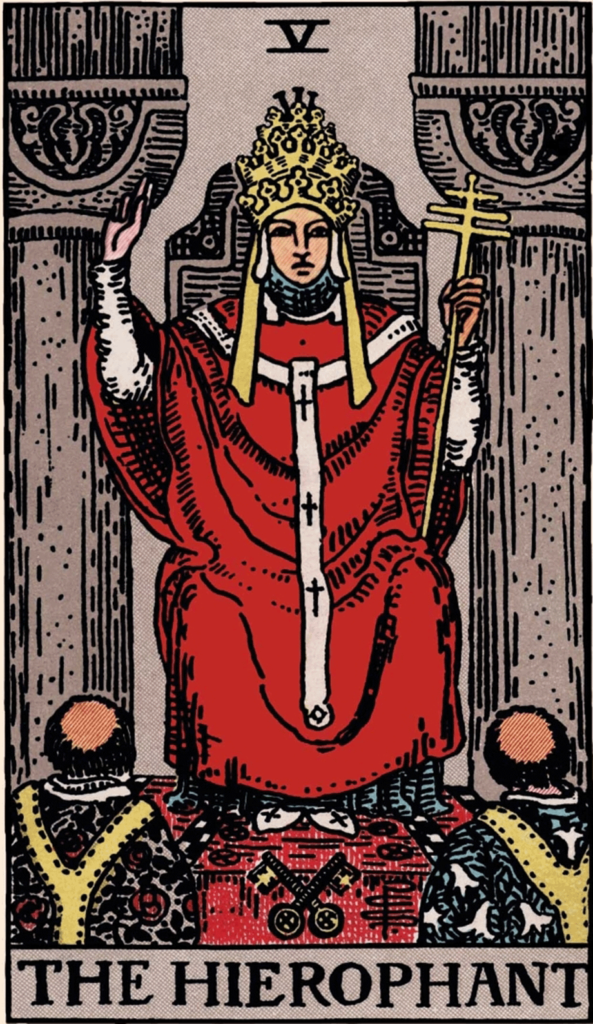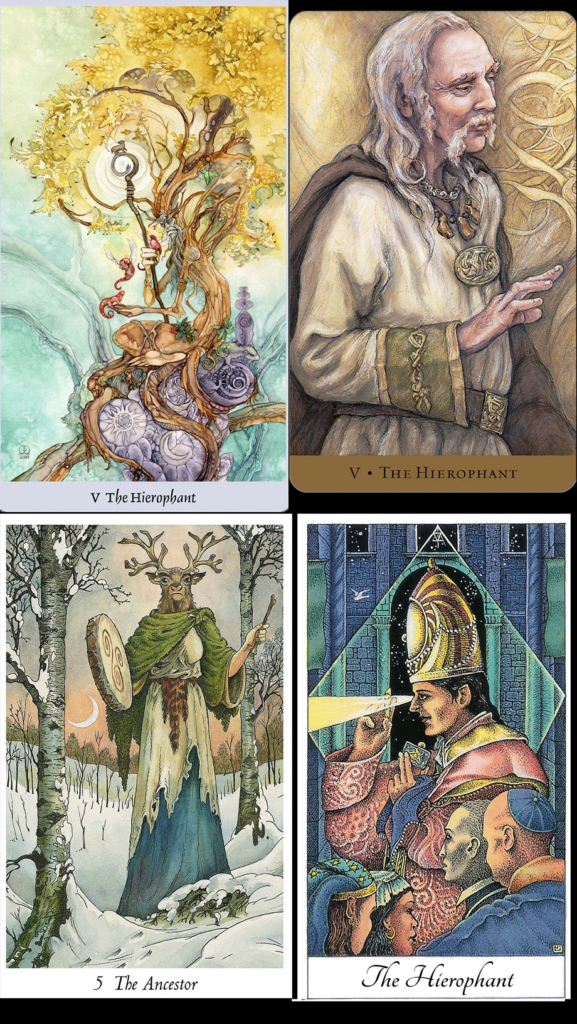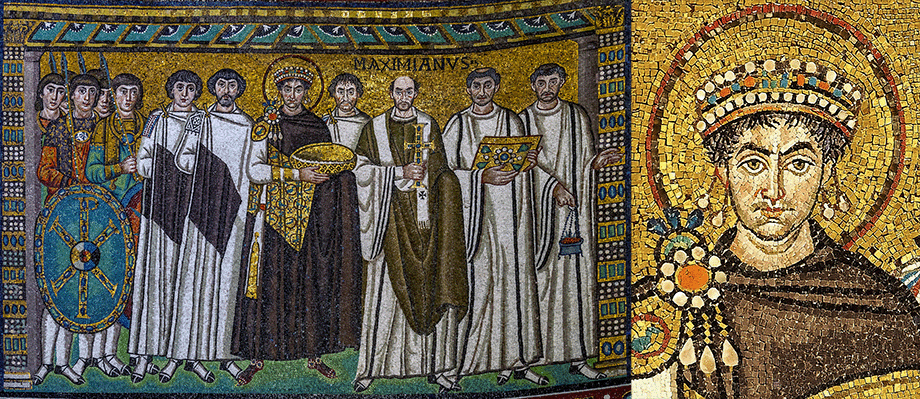The card we find in the Rider Waite Smith deck marked with the XI is named Justice. In other decks this card is found as VIII, placing it between the force of the Chariot and the contemplation of the Hermit. In this now typical position, however, it stands between the unending circuit of Fortune and the unresolved fate of the Hanging Man. While I am not personally an adherent of the so-called “Tarot journey” the arbitrary positioning of these cards, and the numbers that are then assigned to them, can impact how that journey is taken, and perhaps give insight into how the cards speak to each other in their “proper” place. This card, fundamentally, is about that order of things. The symbols here are ancient, and modern meanings have lent interpretations to them that are not what they started as, and such interpretations are not always easily interchangeable.
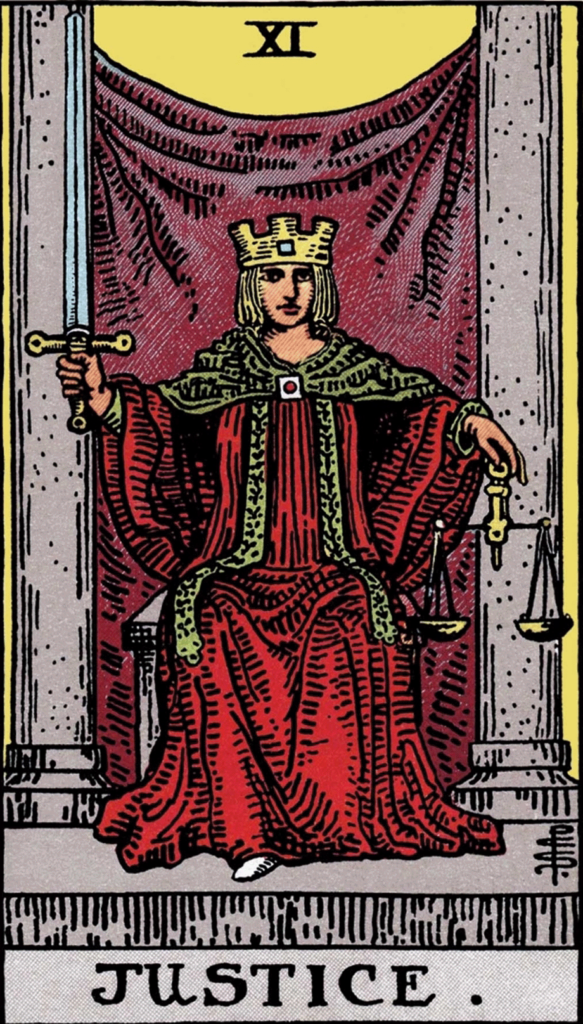
The Justice card returns us to the frontally oriented figure on a throne, flanked by columns or vertical elements, that we have not seen since the Chariot. The positioning links this card with that, as well as with the Hierophant, the Emperor, and the Priestess. The figure here is generally interpreted as female, though in the demi-gothic style Smith is employing that is by no means an absolute. The bobbed hairstyle could certainly indicate a prince or young king, and the robe gives us no tell-tale swellings to determine the true gender of its wearer. The robe is topped with a mantle and tippet, indicative of some official capacity, though not necessarily a religious one. The decoration on the tippet might be laurel leaves. The figure wears a simple open crown with a single blue square gem in the front. A square brooch with a round red gem holds the mantle together. The robe itself is red. Mantle, tippet and undergarment appear to be gold or yellow. The throne is largely obscured, but may be a simple stone bench. The two columns are likewise unadorned, with their capitals are out of view about the top of the card. Between them hangs a purple curtain completely blocking the area behind the figure. Above the figure and to either side of the columns the sky is yellow. From the figure’s left hand depends a simple balance. The right hand wields a sword. The toe of one white boot shows out from under the robe on that side.
I would say that in virtually all of my decks, this card immediately calls to mind the original source image from whence this concept of Justice derives. It is the Weighing of the Heart from the Egyptian Book of the Dead, shown below in the most famous version from the Papyrus of Ani in the British Museum.
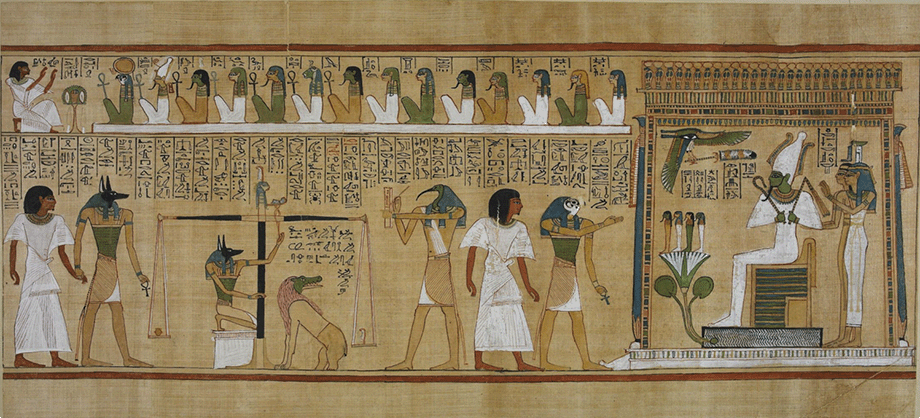
This core tenet of the Egyptian resurrection belief is rather simple. The heart, wherein the Egyptians believe the soul of a person resided, was placed on one side of the balance. On the other was single feather, an incarnation of the goddess Maat, which is variously styled truth, but that is a limiting rendition. If the feather and the heart were balanced, then the soul of the dead was considered to have lived a right and proper life, and was allowed to go on to dwell with Osiris in the Field of Reeds or take their place in the Boat of Ra or both (the Egyptian afterlife is multidimensional in an almost quantum-like nature).
On the other hand, if it weighed heavier than Maat, then it was burdened with evil deeds that were an affront to the gods, and was tossed by Anubis into the waiting maw of Ameet, the Eater of the Dead. This person was now irrevocably and totally gone. Unlike later religions with lakes of fire and brimstone (though you’ll find those in the Book of the Dead) the wages of sin in the Egyptian faith was immediate oblivion. No one would repeat your name down the millions of years. You would be forgotten.
For the ancient Egyptians there was no more terrible or more terrifying fate. The Book of the Dead is compiled from spells and rubrics that were deemed necessary to get the soul to this point, and then insure that his heart did not “lie” about him. I include here the spell in the old form as translated by Budge. There’s a shorter version on Wikipedia, but I prefer the more formal language myself.
My heart, my mother; my heart, my mother! My heart whereby I came into being! May nought stand up to oppose me at [my] judgment, may there be no opposition to me in the presence of the Chiefs (Tchatchau); may there be no parting of thee from me in the presence of him that keepeth the Balance! Thou art my KA, which dwelleth in my body; the god Khnemu who knitteth together and strengtheneth my limbs. Mayest thou come forth into the place of happiness whither we go. May the Sheniu officials, who make the conditions of the lives of men, not cause my name to stink, and may no lies be spoken against me in the presence of the God. [Let it be satisfactory unto us, and let the Listener god be favourable unto us, and let there be joy of heart (to us) at the weighing of words. Let not that which is false be uttered against me before the Great God, the Lord of Amentet. Verily, how great shalt thou be when thou risest in triumph.]
E.A. Wallis Budge – Translation – The Papyrus of Ani; The Egyptian Book of the Dead
The name spellings here are variable depending on the sources. There’s a list of the company of gods in attendance, but generally it’s at least a top ten. 1The Sheniu officials likely refers to the corporeal authorities that had dominion over the living world, so the government, police, and priesthood, all of which were a single entity in Ancient Egypt, with Pharoah at the center. Osiris is chairman of the board and officiates as the Judge. He is accompanied by Isis, of course, and sometimes Horus. He is the one referred to as the Lord of Amentet (the afterlife). Khemnu is the old goat god, part of the Egyptian creation, and will reappear in magic and witchcraft up to the present day. Tehuti/Thoth is the Keeper of the Balance, and in many depictions stands by with a papyrus and reed, waiting to record the name of the Blessed Dead for all eternity. Maat was his consort. He represents the knowledge of the Cosmos, the structure that is written, similarly to the Greek Logos. She represents the Cosmic Order -that which is as it should be. Saying hers is the feather of Truth is connoting a modern meaning that word has, which is not entirely synonymous with the Egyptian idea.
Though translations of the Prayer to the heart talk about the kinds of “sins” we’ve come to equate with evil in a post-monotheist world, it’s an over simplification to put Maat simply as being a good person. Certainly such things as were forbade in some of the Mosaic laws (which probably were borrowed from Egypt and perhaps Mesopotamia) regarding violent crime, theft and deceit, would have been as unacceptable in their civilization as it is ours, because they have an impact on the practical operation of that civilization. But Maat extends to things that would offend the gods, and cause the universe to become unbalanced, which could have catastrophic consequences like famine, plague, earthquakes, sandstorms, and other dangers. Living on a thin strip of green on either side of the Nile, the ancient Egyptians were keenly aware of the need to respect and live harmoniously with their environment. Even today, with modern irrigation, and technological advances, the stark contrast between the viable green of the river valley, and the bleak dust that lies beyond is inescapable. Maat is a lesson for us all, to live life in balance with our world, and to understand our world is the whole of the great Cosmos we inhabit. We must look to the land, to the spirits, to the ancestors, and to the stars, and pay attention.
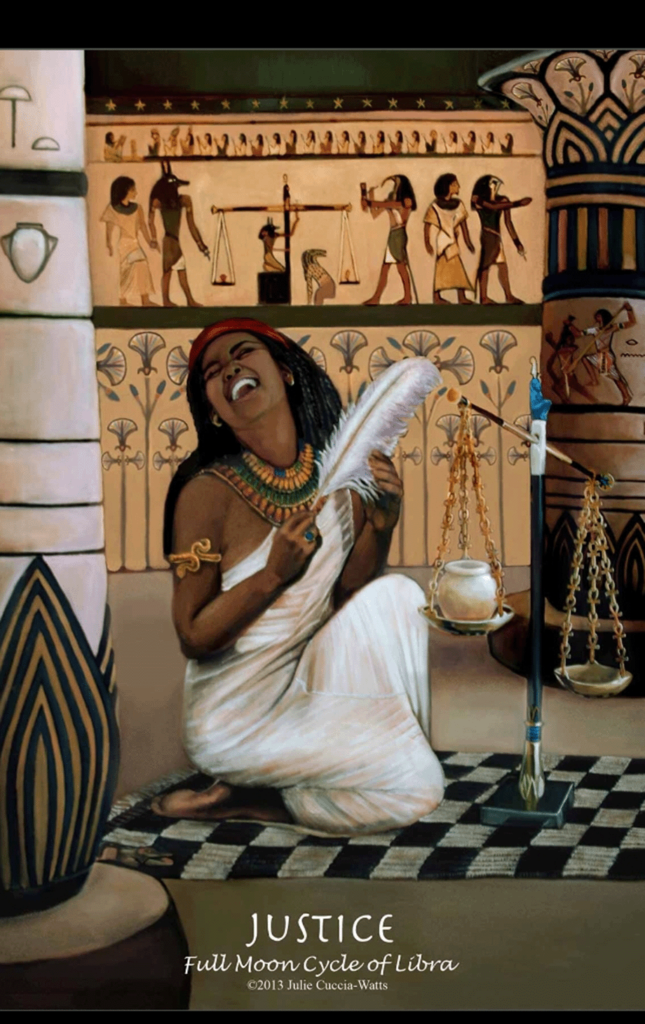
It is this long litany that springs to my mind when the Justice Card comes up in a reading. I include this as preface to my visual exploration of the RWS version, as it is really impossible for me with my background to separate it when trying to interpret the meaning of the card. That said, there are a number of highly useful symbols in Waite that may take us in other directions, and offer access to your imagination and understanding of the idea of Justice.
The word “Justice” itself is loaded with baggage, and more comes with it every day as we make our way through the rubble of the fallen Tower trying to construct our next world atop the ruins of the old. Conflated with it are words like Truth, Fairness, Equity, and Law and Order.
We’ve already examined Truth, but if you’ve ever sat on a jury in the United States, you have been told that “truth” is not the same as “fact”, and your job in the process is to determine if the evidence as presented is a finding of fact. Recent language has introduced the idea of “alternate facts” which Orwell would tell us is double speak. An alternate fact is a lie. Truth, on the other hand, as Obi-Wan tells us, may depend on our point of view.
Fairness is not Justice. Nor is the related word Equity. Both fairness and equity relate to a parity, a sameness to both sides of any dispute. The parable of Solomon and the two woman claiming to be the mother of the same child illustrates this splendidly. Fairness is cutting the baby in half.
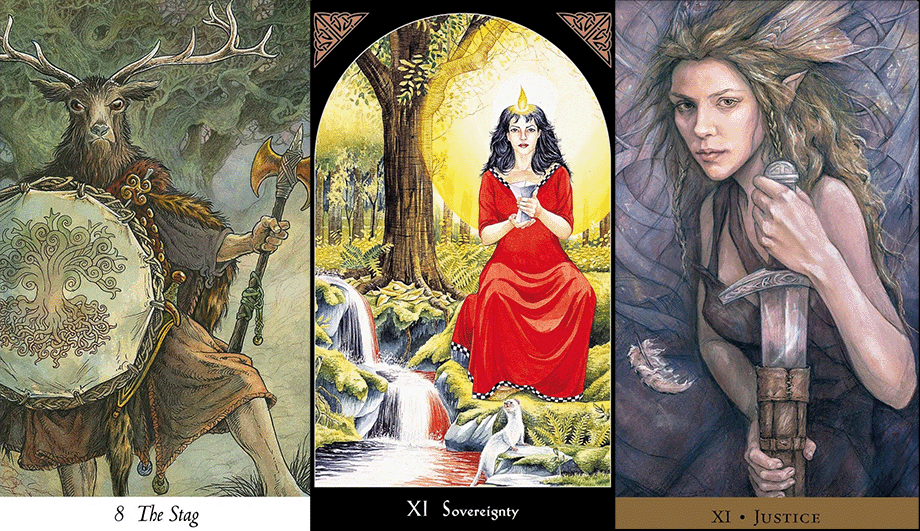
The middle piece is from the Arthurian Tarot by John and Caitlin Matthews and illustrated by Miranda Gray. I have this as a digital deck from The Fool’s Dog, because I have a great interest and respect for the Celtic/Grail Shamanism that the Matthews have brought to us. I have never gotten the hardcopy, though, because I don’t always find the images satisfying. This is an exception, where Justice is styled as Soveriegnty, Per the text, this figure is the goddess of the land, who symbolically is wed to the king and thus endows him the right to rule, and as the old oath goes “to mete justice and dispense mercy”. The stream here runs black, red, and white. I am immediately reminded of the White Well and the Red Well of Glastonbury, long associated with Arthurian myth.
The final card comes from the Tarot of the Hidden Realm, which is a Celtic Faerie deck in general description. Much of the imagery dispenses entirely with the forms of the Rider Waite Smith, and has more similarity to Brian Froud’s Faerie Oracle Decks, though this is by the artist Julia Jeffrey. As you can see, the prominent feature here is the sword, readied but still sheathed. Curiously, the little white Feather of Maat still manages to make an appearance.
While certainly a half a baby would balance against another half a baby in Ye Olde Scale of Ye Olde Justice, we all of us can tell that is not the right solution. We chafe from an early age against having to miss recess because Little Johnny couldn’t behave in math class, even though the rest of us were perfect angels. We seem to have an inherent sense that there is a proper solution, where things are made right, and sometimes that is that things are made fair, and sometimes they are not.
In reality, if we take a big fluffy ostrich plume and place it on a balance with a fairly desicated human heart, we will see that the heart handily outweighs the feather. What makes it work is that both are allegorical. They are symbolic. The feather perhaps has more weight than its nature belies, but again, the heart free from trouble and sin is light.
You will note here that the figure of Justice is not “blind” as she is often depicted in Roman and derived works. The blindness is an allegory for fairness, or equity under law, which I think we all know is also a fallacy. Equity under law is a concept, originating in the Graeco-Roman world but not applying then any moreso than it does today. The patrician, plutarch, and senator stood before a justice who peeked out from under her blindfold, and distinguished them easily from the poor, the plebian, and the slave. So perhaps this Justice is at least being more honest to look us straight in the eye.
The square on the crown and the square brooch hearken to the ideas in Freemasonry that bled over into many of the magical lodges of the idea of Square, Level, and True (or Plumb). Part of the Masonic cornerstone ceremony is the testing of the stone by three officiators, with ceremonial instruments to determine if the corner are square, the top is level horizontally and the sides are straight vertically (true or plumb). These characteristics are essential for the cornerstone, since all the other stones will inherit their alignment from it.
I find it rather fascinating that the Egyptian architects of pyramids and temples had a single simple device that performed all of these functions. Oh, and if you’re an initiate, you can also use it to calculate your position according the stars, the circumference of the earth, and a lot of other nifty things. And the creation of this magic device is based on a deft use of light and shadow.
A string, with a weight on one end, will always point straight down. It will cast a shadow at a right angle to the string. Now I know that seems counter intuitive, because sundials work due to shadows apparently having different angle, but if I have a straight line, the shadow of that line is going to form a right angle at the point where the line reaches the ground. So I take my straight string. I put a straight stick in the ground that lines up with it. The shadow of that stick is at a right angle, and so I take a second stick and align it with the shadow and now I have a square. Then I take that square, and tie my weighted string to the point in the middle where the two sticks join. I go find a pond or a bucket of water. I take the ends of the sticks and dip them into the water until the down pointing string is exactly in the middle. I mark where the water is, and cut the ends of the sticks off. Because water always seeks level, the ends are now a device to mark our level blocks. I can use the corner to determine square, and the weighted string to determine plumb.
And I have accomplished this using the fire of the sun, the shadow cast on the earth by a string suspended in the air and leveled against a pool of water.
This device is the ancestor of the quadrant, the sextant, the astrolabe, the surveyor’s theodolite, and a plethora of instruments used for navigation, construction, and even space travel. That seems pretty powerful magic to me.
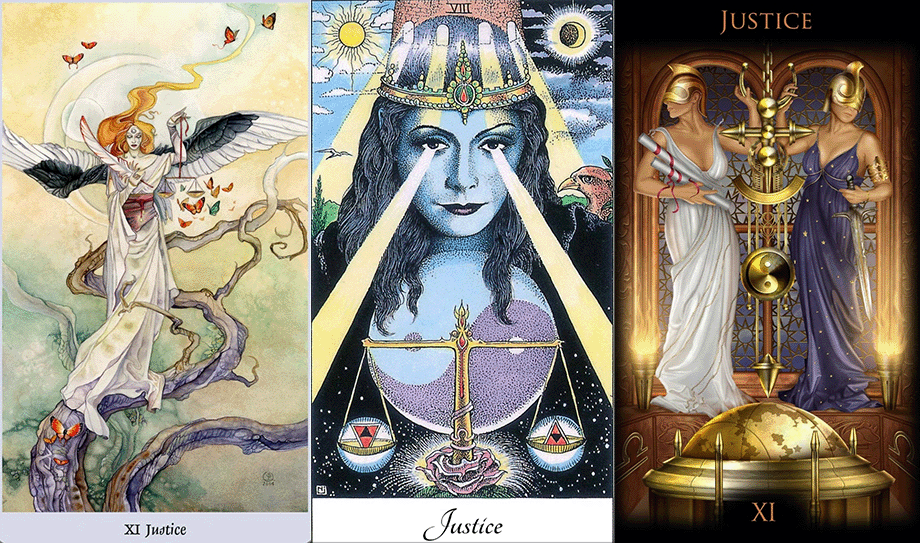
The middle image is taken from the Cosmic Tarot and reflects that decks combination of Eastern esotericism, Buddhist mysticism, alchemy, and the traditions of the lodge magicians. Maat shines forth as the balance here, of the universe as a whole, not just the human realm with its ideologies and self-imposed strictures. Truth and Justice are cosmic concepts, not perhaps easily, or correctly, comprehended by the mind of humankind.
The righthand image is from Cirro Marchetti’s Legacy of the Divine Tarot. This might best be characterized as the Tarot one might expect from the Cirque de Soliel. Indeed, it features acrobats on draperies among other such images. However, the context here is that it is an imaginary deck composed in a post-apocalyptic world of our future, where the ancient wisdoms are being rediscovered, and a new Tarot devised. From that intriguing perspective, the symbols, already delicious, take on many additional significances. The journey through these cards is warm and wonderful.
What has it to do with Justice? Well only that it’s hidden in that little gem on the forehead, and the brooch with the red center tells us that we live in an ordered universe, where such things are not only possible but within our own understanding. It is our obligation to perceive and respond to that order, to keep it, both in the physical sense, and the spiritual one. The Masonic cornerstone is an allegory of the perfecting of the human spirit.
We should contrast here how Justice holds the sword versus how the Sphinx on top of the Wheel holds the sword. The Sphinx has it. It’s there. It’s waiting. But it’s not ready to strike. This tells us that the nature of Fortune is to be enigmatic. We know that some doom awaits (and doom in that old sense of destiny) but we won’t know it until it arrives.
Justice on the other hand wields the sword. The hand firmly grips the hilt and the blade is poised to swing down. The red of the robe is the lifeblood. The sword, like the axe in the center of the Roman fasces, is symbolic that ultimate penalty, death. The purple curtain behind Justice is emblem of the State, the Authority or whatever Entity, corporeal or cosmic, that renders judgment of the tipping of the balance and demands such an awful penalty.
The card is severe. Unlike Fortune’s Wheel, where we don’t see the end coming, and may blithely ride around sampling the rewards and retributions or random luck, when we are before Justice’s unflinching gaze, we must hope that our heart not bear false witness against us.
Yet that small bit of white at the bottom where the right foot peeks out, can only mean that mercy is available. It is not automatic, of course, and it has to overcome all the much larger forces going on in that card, but it is present. Without the possibility of mercy, there is no true Justice. There always has to be some chance, that even when all things weigh against us, the balance may yet tip in our favor.
We can have then some hope, that the radiance of that yellow sky behind the purple banner of Authority will shine down upon us, as it does the Fool, the Magician, the Empress, the Lovers, the Chariot and Strength. Consequently, this is the last we see of that brilliant sky in the Major Arcana. The succeeding five cards go from grey to black, and take us through the heart of darkness. We’ll start that descent next week with the Hanged Man.
Until then, thank you for reading to the end. I hope you have found it beneficial.



